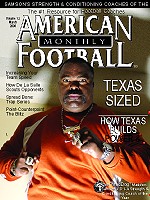AMERICAN FOOTBALL MONTHLY THE #1 RESOURCE FOR FOOTBALL COACHES
Article CategoriesAFM Magazine
|
Point Counterpoint - The Blitzby: Terry Jacoby© More from this issue Peyton Manning and the Indianapolis Colts were helpless against the Pittsburgh Steelers and their blitz packages in last monthís AFC playoff game. Manning, the master of the audible and gameís best gunslinger, spent most of the afternoon forcing passes, trying to avoid getting crushed or getting crushed. After the game, Manning hinted that he didnít have the best protection. The offensive line, running backs, extra blockers and offensive coaches couldnít slow down the hard-charging Steelers. Manning was right about one thing. It takes a team effort to stop the blitz. And with defensive coordinators picking apart game film, looking for the smallest clink in the armor and exploiting it to the max, offenses need to be prepared as much as possible for whatís coming at them full-speed ahead. <....The full article can only be seen by subscribers. Subscribe today!
|
|
|||||||
| HOME |
MAGAZINE |
SUBSCRIBE | ONLINE COLUMNISTS | COACHING VIDEOS |
Copyright 2025, AmericanFootballMonthly.com
All Rights Reserved





